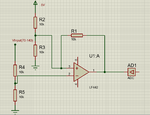cartman007
Member level 2
Hey Guys
I need to be able to read voltage readings from 9V - 20V and from 70V - 140V with a Atmega 168 5V ADC input.
Now ive tried the simple resistor divider but because im a really cautious person, I really do not like the idea of high voltage NOT being isolated from my MCU.
So ive looked at some circuits with Op-Amps. Problem with the Op-Amps is I cant seem to do the math right.
I cant seem to upload pictures cause ive drawn the circuit specifically for you but it seems there is some kind of error : /
So the current Op-Amp circuit has 2 sets of Voltage dividers on each Inverting and Non-Inverting inputs. It also has a resistor on the output as feedback to the Inverting pin.
The Non-Inverting pin's voltage divider will be the Measuring pin and the Inverting Pin will have 5V connected to it.
Hope that is clear enough.

So my problem is I cant seem to get the Math right!
No matter what I try I keep on getting strange values...Sometimes the output is 5V when the input is at max(140V) and when I go down to 70V it either goes negative or stays roughly the same.
Could someone please give me a trust worthy ADC circuit with the MATH formulas please?
Thanks guys
I need to be able to read voltage readings from 9V - 20V and from 70V - 140V with a Atmega 168 5V ADC input.
Now ive tried the simple resistor divider but because im a really cautious person, I really do not like the idea of high voltage NOT being isolated from my MCU.
So ive looked at some circuits with Op-Amps. Problem with the Op-Amps is I cant seem to do the math right.
I cant seem to upload pictures cause ive drawn the circuit specifically for you but it seems there is some kind of error : /
So the current Op-Amp circuit has 2 sets of Voltage dividers on each Inverting and Non-Inverting inputs. It also has a resistor on the output as feedback to the Inverting pin.
The Non-Inverting pin's voltage divider will be the Measuring pin and the Inverting Pin will have 5V connected to it.
Hope that is clear enough.

So my problem is I cant seem to get the Math right!
No matter what I try I keep on getting strange values...Sometimes the output is 5V when the input is at max(140V) and when I go down to 70V it either goes negative or stays roughly the same.
Could someone please give me a trust worthy ADC circuit with the MATH formulas please?
Thanks guys
